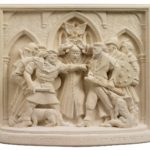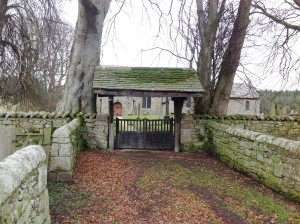St Michael and All Angels, Alnham
The parish church of St Michael and All Angels in the tiny village of Alnham is set on the edge of the Northumbrian National Park, close to the source of the River Aln and somewhat off the beaten track.
The original parish of Alnham covered over 12, 300 acres. It stretched from almost the Scottish border in the north and the summit of Cheviot Hill to Whittingham in the east and Kidland in the west. It included the townships of Alnham, Prendwick, Scrainwood and Unthank. In 1959 Alnham Parish was united with the Parishes of Alwinton and Holystone, which in turned merged with the Parish of Rothbury, Thropton and Hepple in 2004 to become the Parish of Upper Coquetdale.
The earliest written records of a church on this site are in 1135 when William de Vesty gave the church to the monks of Alnwick Abbey. It is likely that there was a church here before this time when the Lord of the Manor (the remains of the ancient manor house are to be found on the south side of the River Aln opposite the church) would have maintained the church at his own expense. It might well be that the church yard is older than the church, whilst in relative terms the lych-gate in modern there are three ancient socketted bases for crosses standing close to it.
In giving the Church to the monks, William de Vesty transferred the right to nominate the new incumbent parish priest from the lay manorial proprietor to ecclesiastical institutions thus obtained a relatively cheap way for himself to gain monastic gratitude and important spiritual benefits which would flow from such donations in the form of prayers offered by the monks for the souls of such a patron. It has been suggested that the monks rebuilt or at least altered the church at this time, and indeed there are traces of an arcade on the outside of the north wall suggesting that at one time there was also a north aisle to the church.
Being close to the Scottish Border, Alnham has seen some troubled times. It is believed that the original church was built on the site of a small Roman camp, which most probably was used as a centurion’s guard to protect their herds of cattle when grazing during the summer in the rich pastures on the bank of the river Aln above Whittingham. We have no solid confirmation of this except for other roman works both at Black Chester a mile to the south of the church, and a Roman fort about a mile west on Castle Hill where a semi circular encampment was built, defended by two outward ramparts and a deep fosse.
Further evidence of a turbulent past is the Pele House (pronounced peel) next door on the west side of the church. Built in the 14th century during the reign of Edward III it was described as the “little tower” in documents of 1541. This grade two listed building would have been built as protection from the raiding Scots and also against local outlaws. (In 1256 the Northumberland Assize Rolls tell us that out of 77 murderers only 4 were justly punished the remainder were simply outlawed).
The Pele House eventually became the vicarage and was renamed The Vicar’s Pele but fell into ruin in the 17th century when the vicar then resided at Ilderton, holding many of Alnham’s parish records there. The Tower was restored in 1844 and is now a private house.
Perhaps one reason for such for ill gotten gains and lawlessness in the area may have been the rich pickings from the English merchants taking salt to Scotland along the Salt Road to the west of the Church and their Scottish counterparts bringing cattle to be sold in England, not to mention the original concept of duty free – illicit whisky distilleries in the hills.
Alnham Church has connections to the gunpowder plot of 1605. In part of a formal written document of 1597, Henry, ninth Earl of Northumberland writes to his cousin, Thomas Percy, one of the leaders of the plot to blow up the King and Parliament. It says:
“The very true and undoubted patrone of the parishe and church of Alnehame sending greetings in the Lord God Everlasting, grantes by his writing to my beloved Cosyn Thomas Percy, his executors, and assignees, the first and next advowsone, donation, nomination, presentation and free disposition of the Rectory and Parsonage of the Parish Church of Alneham”
Inside the Church, itself a grade one listed building, there is a font dated 1664 and placed in the Church at the time of the English Civil War. It is said that Cromwell visited Little Ryle on the parish boundary. (Little Ryle being part of the Collingwood House Estate; there are many referrals in and around the church to the Collingwood family). The coat of arms and heraldic inscriptions on the font connect the Church with the Percy Family of Alnwick Castle whilst the monuments to the west of the font are rather interesting; one ends with the inscription “and so forth”, perhaps a sign of a bored stone mason? At the back of the church is the gravestone George Adder, the son Robert Adder who then resided at Prendwick. He perished whilst trying to cross the River Tweed in 1611 at Henderside ford at Kelso. His body was recovered further down stream at Sharpit Law. The Church registers date from 1688 and the bell is inscribed “Alnham 1759”
The fireplace on the north wall of the church opposite the south door was added in the nineteenth century fireplace; it has a joggled lintel carried on shaped corbels perhaps copied from the one in Edlingham castle.
The sanctuary of the Church was refurbished in 1938 when the east stained glass window, alter panelling communion rail where given in memory of Adam Scott by his wife; his mother donating the clergy desks in memory of the same. The Latin at the base of the window is taken from Isaiah Chapter 60 V3 “the nations shall march towards your light”. Adam Scott died in 1925 after breaking his neck after falling from his horse at Kelso races. He is buried in the church yard at the east end of the church in his racing colours. The Scott family were originally from Scotland but lived at Alnham House. The 1881 census records show that when Adam was just 5 his father farmed the 4 400 acres that went with Alnham House, employing 50 labourers and shepherds.
After World War Two local parishioners raised sufficient funds (£800) to restore the chancel which had fallen into disrepair and day light could be seen through the roof. In the chancel there are four medieval tombs; the two to the north marked his – an inscription of a sword or maybe a spade, and hers – an inscription of a pair of scissors.
In 1953 the remainder of the Church was restored at the expense of a single local benefactor, Gustav Renwick from Holystone Grange. Behind the door in the church there is a photograph of the reopening of the church following this refurbishment, amongst other things it shows that fifty years ago the beech trees at the end of the church path were not pressed up against the lychgate as they are now! “The Major” as Mr Renwick was referred to died in 1956 and is buried between the south porch and transept. A stone to his memory can be found in the porch. Lighting and heating were added between 1960 and 1964 when the nave, transept and vestry were re roofed at a cost of £ 4,000.
Following the sale of Alnham War Memorial Hall and its conversion to a private house a few years ago, the role of honour which was contained therein bearing the names of the members of the parish who gave their lives in World War One was transferred to the church and can be seen on the north wall of the nave. It also gives the names of those from the parish who served in the Great War. The Latin inscription, pro patria, means “for their native land.”
More recently, the Church was the starting point for the dedication of a Cairn erected on the hill out toward Ewartly Shank to commemorate the 45th anniversary of the death of two shepherds, Jock Scott and Willey Micklemass who froze to death in a blizzard in 1962. Their deaths led to the establishment on the Northumbrian National Park Mountain Rescue Service.
As for the last 900 years and more, the Church today is a witness to Christ and a symbol of faith in the magnificent Northumbrian hills. Church services are held on the first Sunday of every month – 11.30 am in the summer, 6.30 pm in the winter. The church is still used for marriages, christenings and funerals and forms the centre of a small but thriving community. It is open on a daily basis for quite reflection and prayer and as a lasting monument to the Glory of God. We would be pleased for you to write in the visitors’ books and add any comments and also, if you wish, become a friend of Alnham Church to be kept updated with the happenings in this beautiful rural parish.


